
Original Link: https://www.anandtech.com/show/4357/moneual-sonamu-g100-back-to-the-future
Moneual Sonamu G100: Back to the Future
by Dustin Sklavos on June 7, 2011 12:01 AM EST- Posted in
- Cases/Cooling/PSUs
- mid-tower
- Moneual
Introducing the Moneual Sonamu G100
One of the joys of doing case reviews is getting to see more exotic designs from smaller vendors looking to make their mark. Some of them are like ASRock has traditionally been with desktop motherboards, innovating in new (and often strange ways) and adding features or going after markets bigger names don't traditionally gun for. Such is the case with Moneual's Sonamu G100, an enclosure designed specifically to reduce standby power consumption of not just your desktop, but reduce or even eliminate the power consumption of the peripherals plugged into it. That's the theory at least, but how does it work out in practice?
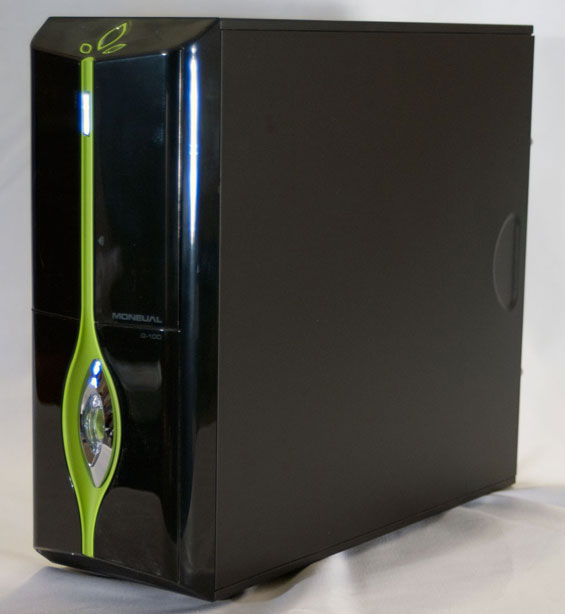
Judging from the press pamphlet, Moneual's claim to fame with the Sonamu G100 is that it can substantially reduce the amount of wasted power drawn by peripherals connected to it. This is handled by a power outlet on the back of the case and toggled using the "Green Button" at the front top. And yes, I said "power outlet." As you'll see later, there's the usual input power, but there's also a three-pronged power outlet that allows you to effectively put the Sonamu G100 directly between the wall and your peripheral hardware.
| Moneual Sonamu G100 Specifications | ||
| Motherboard Form Factor | Micro ATX, Mini ITX | |
| Drive Bays | External | 1x 5.25" |
| Internal | 3x 3.5" | |
| Cooling | Front | - |
| Rear | 1x 60mm exhaust fan, 1x 60mm fan mount | |
| Top | - | |
| Side | - | |
| Bottom | - | |
| Expansion Slots | 4 | |
| Front I/O Port | 2x USB 2.0, mic and headphone jacks, SD/MMC card reader | |
| Top I/O Port | - | |
| Power Supply Size | Micro ATX; 300-watt power supply included | |
| Clearance | 8" (Expansion Cards), 105mm (CPU HSF) | |
| Weight | 11 lbs. | |
| Dimensions | 16.5" x 5.75" x 14" | |
| Price | $139 | |
The Sonamu G100 includes a 300W Logisys brand micro ATX power supply, rated for "250W average, 350W peak," which can be swapped out and replaced with a bit of work. This power supply is honestly pretty dire, and you'll see more once we really get into it.
In and Around the Moneual Sonamu G100
I'll admit to being a big fan of small cases. There's usually a lot of innovation and creative engineering that can occur in trying to cram a custom computer into a small enclosure. You'll remember I liked SilverStone's FT03, which had a very clever design and a unique look that may not have been right for everyone but definitely worked for me.
The black and green two-tone of the Moneual Sonamu G100 ties into the enclosure's environmentally friendly message, but it's also reasonably attractive: green is an uncommon color on cases, but that doesn't necessarily mean it's a bad color. Unfortunately, the front face of the G100 uses glossy black plastic that's extremely prone to smudging, made worse by the fact that to get to the USB and audio ports (and card reader), you have to press the panel to make it spring open. That means your fingerprints are always going to be square at the top of the enclosure. I tried wiping my fingerprints off with a microfiber cloth and met with limited success.
As for the rest of the external shell, the side and top panels are decent enough quality steel, painted black. There are two vents in the left panel, but they didn't quite line up with the processor's heatsink or the PCI Express slot. That's probably just as well, because once we get to the back of the G100 we start to learn that there's trouble in Moneual's green paradise.

First, the secret of the design is simple: a power lead from the wall, and to its left a power outlet. The G100 essentially bridges the two connections and has a little bit of hardware inside that allows the tower to control whether or not power goes out to that outlet. It's not really rocket science, and in fact if any of you out there are old enough you're liable to remember the brief period of time when monitors plugged into a computer's power supply instead of the wall. [Jarred: Raises hand.]
This isn't necessarily anything too new; they just added a couple of extra controls to it. When the computer enters sleep mode, you can have the G100 completely cut the power to anything plugged into it. In fact, if you want to save even more power, there's a master power switch on the front next to the USB ports that can completely shut off the power supply. And that's how you get your "standby zero" as Moneual calls it: you just shut everything off. Of course unless you read a review you won't know any of this because the G100's included instructions are staggeringly bare and have no text about what's supposed to be the enclosure's big selling point.
The exhaust cooling is handled by a single 60mm fan (though there's a mount for a second fan), and the expansion slots aren't covered by brackets but have to actually be punched out of the case. That's not a huge issue when you're talking about cases that are under $100, but keep in mind that the Sonamu G100 is selling for $139. Almost as a token gesture, a single replacement bracket is included with the case. Things get a lot worse when you open up the case.
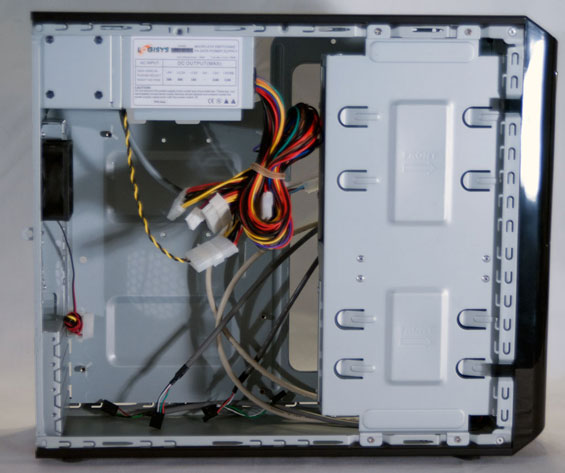
Inside the G100 lies its Achilles' Heel, the Logisys power supply. This is a $20 unit, cheap by any standard, and flies in the face of what Moneual claims to be trying to accomplish with the G100. It's a low-efficiency, generic micro ATX power supply with a grand total of 16 amps on the 12V rail. And it gets so much worse.
We received a review request for the G100 in January of this year, but you wouldn't know it to examine the insides. While the internal layout isn't particularly poor, the removable drive tray doesn't feature any way to mount a 2.5" drive, and that dismal power supply features a grand total of one SATA power connector. All the individual wires are loose, too, being bound more or less by the plugs at the end, with barely so much as a zip-tie to be found among them.
Overally construction quality isn't what I'd consider poor and the case at least feels fairly sturdy, but between the glossy plastic, the horrible power supply, the fact that the 60mm fan doesn't have a pin header and instead uses a standard molex connector, and the lack of a 2.5" drive mount, it's hard not to feel at least a little ripped off when I look at that $139 price tag.
Assembling the Moneual Sonamu G100
The essential problem in assembling the Sonamu G100 is that it really should be easier than it is. The removable drive tray is easy enough work with, but you'll run into several annoyances in the process.
By taking out the drive tray and moving the power cables you wind up with a healthy amount of room to work inside the G100. Popping the motherboard in is easy enough, but connecting the front panel headers is still troublesome due to the card reader using only a five-pin connection instead of a ten. Maybe I'm spoiled, but I've gotten used to USB headers being keyed and easy to plug in, so having to consult the manual was a small nuisance.

This is, of course, nothing compared to the drive tray. Nothing here is toolless, everything has to be secured using screws, and there isn't an ounce of care taken to reducing vibration—there are no rubber grommets, and worse, no 2.5" drive mount. That makes the G100 the first case I've tested for AnandTech that didn't offer a way to easily mount an SSD—exactly the kind of hardware that belongs in a micro ATX, "environmentally friendly" case. That also means I had to go digging through my hardware boxes to find a 2.5"-to-3.5" mounting kit.
Expansion card clearance is also a fairly low eight inches, so whatever cheap entertainment I'd hoped to glean from trying to power a GeForce GTX 580 with the bargain basement Logisys power supply was stolen from me. This isn't actually a huge issue since anyone who tries to mount such a powerful graphics card in an enclosure like this deserves what they get.
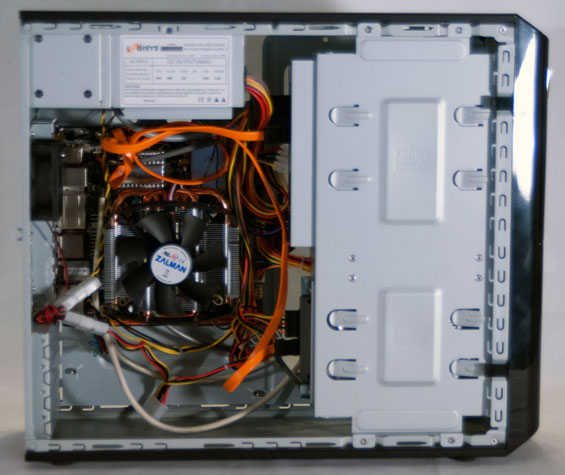
Where the pain sets in is routing and connecting cables. There isn't any clearance or routing behind the motherboard tray (nor a cutout for mounting heatsinks), and the power supply turns the whole experience sour in a hurry. Including just a single SATA lead off of the power supply is inexcusable in this day and age, especially when there's a floppy drive power connector. For what intended use, I can't say, since there isn't anywhere to actually put a floppy drive in the G100. Having to dig back through my boxes of hardware to find a molex-to-SATA converter was an experience I hadn't expected to have. Not being able to take advantage of hardware fan control with the included 60mm is frustrating, too.
And then there's the fact that because the power supply must have come out of a Cracker Jack box, every wire in it is loose and results in the kind of cable spaghetti people buying even a $40 Antec power supply can thankfully avoid. Every expense was spared here. But it's okay: Moneual includes a couple of zip ties for your trouble, and you'll want to use those to keep the wires from the power supply from going wherever they please.
Honestly, the more I delved into assembling the Sonamu G100, the more my irritation grew. Any enclosure released in the past five years should be better equipped than this, and for all of Moneual's talk of conservationalism and saving power they ice the cake by dumping an awful power supply into their case. Having to suddenly dig through my hardware just to find the necessary adapters for basic tasks that every other case I've reviewed can handle fine on their own was inexcusable, particularly given the target market.
Testing Methodology
For testing Micro-ATX and Mini-ITX cases, we use the following standardized testbed in its stock configuration and a Zotac GeForce GTX 580 in cases that support it to get a feel for how the case handles heat and noise. Due to the Moneual Sonamu G100's eight inches of expansion card clearance, we were unable to provide additional results using the GTX 580.
| Mini-ITX/Micro-ATX Test Configuration | |
| CPU | Intel Core i3-530 (73W TDP) |
| Motherboard | Zotac H55ITX-WiFi |
| Graphics Card | Intel HD Graphics (IGP) |
| Memory | 2x2GB Crucial Ballistix Smart Tracer DDR3-1600 |
| Drives |
Samsung 5.25" BD-ROM/DVDRW Drive Kingston SSDNow V+ 100 64GB SSD Western Digital Caviar Black 1TB SATA 6Gbps |
| CPU Cooler | Zalman CNPS8000A with Cooler Master ThermalFusion 400 |
| Power Supply | Included Logisys 350W PSU |
A refresher on how we test:
Acoustic testing is standardized on a foot from the front of the case, using the Extech SL10 with an ambient noise floor of ~32dB. For reference, that's what my silent apartment measures with nothing running, testing acoustics in the dead of night (usually between 1am and 3am). A lot of us sit about a foot away from our computers, so this should be a fairly accurate representation of the kind of noise the case generates, and it's close enough to get noise levels that should register above ambient.
Thermal testing is run with the computer having idled at the desktop for fifteen minutes, and again with the computer running both Furmark (where applicable) and Prime95 (less one thread when a GPU is being used) for fifteen minutes. I've found that leaving one thread open in Prime95 allows the processor to heat up enough while making sure Furmark isn't CPU-limited. We're using the thermal diodes included with the hardware to keep everything standardized, and ambient testing temperature is always between 71F and 74F. Processor temperatures reported are the average of the CPU cores.
For more details on how we arrived at this testbed, you can check out our introductory passage in the review for the SilverStone FT03.
Last but not least, we'd also like to thank the vendors who made our testbed possible:
Thank You!
We have some thanks in order before we press on:
- Thank you to Crucial for providing us with the Ballistix Smart Tracer memory we used to add memory thermals to our testing.
- Thank you to Zalman for providing us with the CNPS8000A heatsink and fan unit we used.
- Thank you to Kingston for providing us with the SSDNow V+ 100 SSD.
- Thank you to CyberPower for providing us with the Western Digital Caviar Black hard drive and the optical drive.
Noise and Thermal Testing
Since the Moneual Sonamu G100 is fairly well ventilated, testing using only the Intel Core i3-530's IGP should result in reasonable heat and noise output. The only fan that has to work full bore all the time is the 60mm exhaust fan, but we're talking about a grand total of less than 100 watts needing to be dissipated under load.
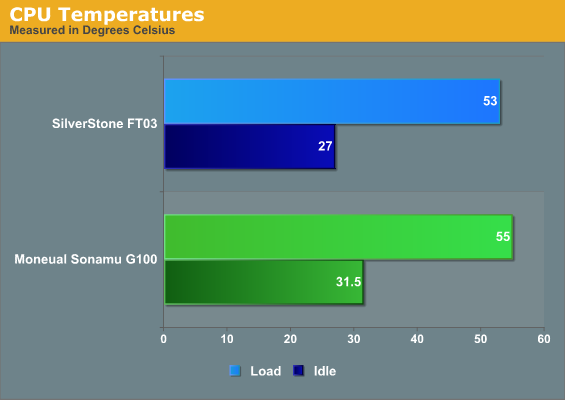
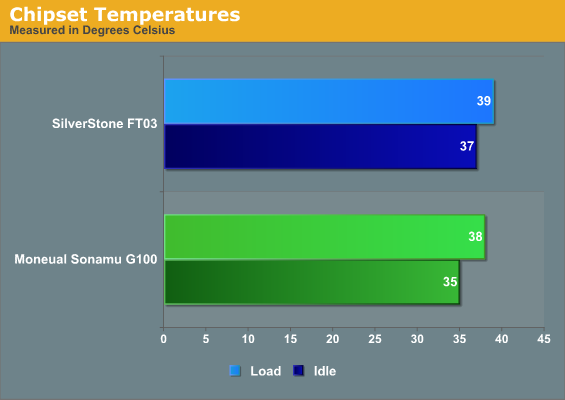
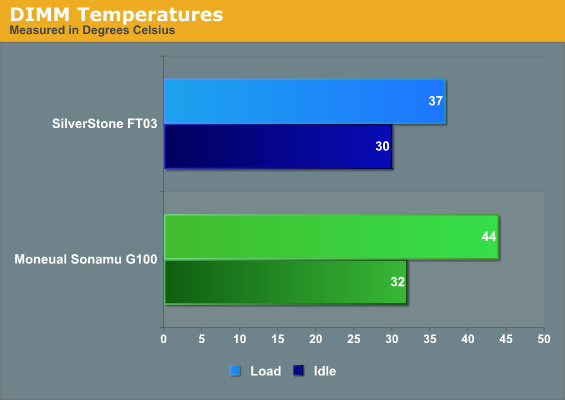
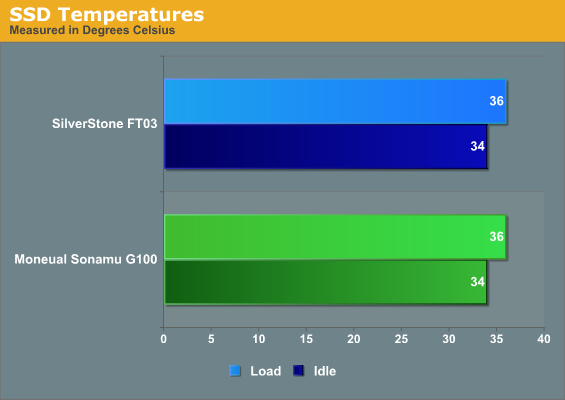
Thermals are generally better on the slightly more expensive SilverStone FT03, but that's to be expected: the FT03 isn't just more expensive, I've also seen it cool two NVIDIA GeForce GTX 580s in SLI. It's designed to handle substantial thermal loads. Still, the G100 puts in a reasonable performance, though the RAM gets a bit warm, likely because it's buried under wayward power cables.
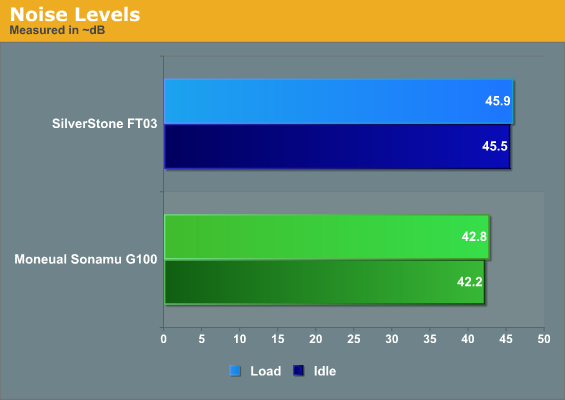
Noise levels in the G100 also stay relatively low, but that's to be expected given the single 60mm fan and efficient hardware. This case isn't designed for heavy duty performance hardware, but for its intended purposes it gets the job done and it does so quietly.
Conclusion: Welcome Back to 1995
I have a history of being snarky whenever I don't like something or it bothers me. It's a history that's served me well doing stand-up, writing blogs, or just entertaining friends, but it's something I found myself having to try and rein in while working on this review. Opening up the case and discovering just how badly Moneual had cut corners, especially with how hard they push their "Green Button" and innovative power design, was disconcerting. Worse, it reeked of hucksterism.
Moneual has a lot of very slick looking HTPC cases available that I wouldn't mind bringing in to test, but the Sonamu G100 was outdated the day it shipped. Why do I keep talking about it like it's a relic? Simple: because despite their press release and all the talk of proprietary technology, what they've essentially done is install a bridge between the power supply and the wall plug and allow the computer's power state to govern whether or not peripherals plugged into the case receive power. That's not innovation, that's something monitors in 1995 were doing. And it's true, if you press the main power switch on the front of the case, it'll cut power to the computer and everything plugged into it, but you know what else will do that? Hitting the switch on your surge protector.
None of this would bother me anywhere near as much if the price tag on the case was reasonable, but it's not—it's nowhere close. $139 is highway robbery for a case with a power switch on the front and an included $20 power supply. It can't mount a 2.5" drive on its own, the power supply's connectors are brutally outdated, and just to put a little stank on it, the expansion slots have to be punched out. If Moneual sold this case for what it was worth, between $50 and $70, I could take a lot of these cut corners on the chin. Yet the marketing and high price tag make me feel like it was targeted to poor rubes who just wanted a more efficient computer and are willing to buy anything with the word "green" on it.
You'll note I haven't even really touched on the "Green Button" functionality, and the reason for that is two-fold: first, I've already explained how most of it works and taken the magic out of the equation. Second, Moneual doesn't tell you in the documentation that comes with the case anyhow. And third, with such a low efficiency power supply installed, how much does it even matter? Most peripherals draw very little power when they idle these days, so a healthy amount of whatever you hoped to save is going to get gobbled up by the low efficiency power supply when you do deign to use your computer for work. So yes, theoretically the switch allows you to shut down everything connected to the computer while the computer itself is asleep, or you can set a timer for the computer to idle out and put everything to sleep (how to do this isn't readily obvious or even explained in the documentation either), but does it honestly matter?
The Moneual Sonamu G100 works as a basic enclosure, but it does the same job any $60 case can do. They took old technology, tarted it up a bit, wrapped it in a big green bow, and asked you to pay $139 for it. If they really cared about being green, they should have put in an efficient PSU as the first criteria. Seasonic has a 300W 80 Plus Bronze that would do the trick (and still leave plenty of room for profit)—but it doesn't have an AT-style monitor plug.
Update: Moneual seems to have heard at least some of our complaints, along with those of our peers. They've released a revision on the Sonamu G100 that includes an 80 Plus Bronze certified power supply. It's $10 extra, which seems a bit steep given the G100's already high price, but it's definitely a step in the right direction. That revision can be found here.



















